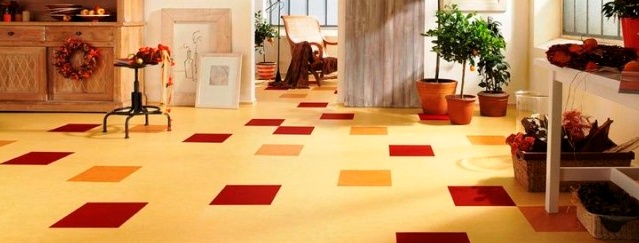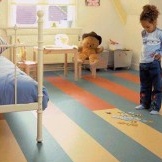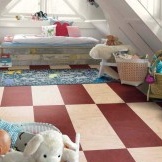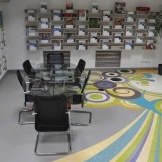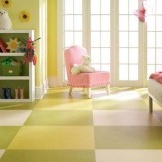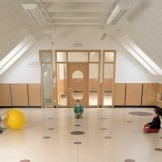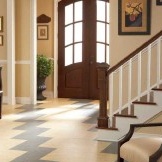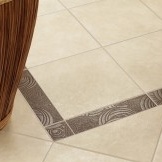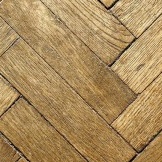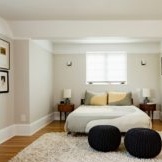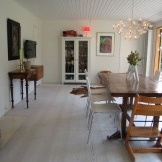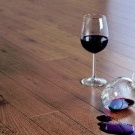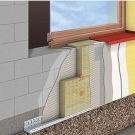Marmoleum
The environmental friendliness of building materials plays a huge role in interior design. Marmoleum is a flooring material made exclusively from natural natural ingredients such as limestone, linseed oil, cork chips, natural resins, wood flour, gum, jute fabric, dry matter and natural color pigments. In other words, marmoleum is the same linoleum, only natural. It also contains an additional water-based surface coating (Topshield), which provides reliable protection against wear, as well as various scratches. In addition, the coating greatly facilitates cleaning.
Marmoleum scope
The material is so resistant to any influences that it is versatile enough and suitable for any room, even medical and children's. Judge for yourself - the coating almost does not burn, even from an extinguished cigarette there are no traces on it, it has high sound absorption, is not afraid of things like furniture wheels, women's heels and pet claws, i.e. The material has excellent consumer properties. Moreover, the marmoleum is endowed with a unique feature, with time it becomes even harder, and therefore last longer. All these advantages make him the main contender for the flooring of children's rooms, as well as kitchens (for the kitchen he is just a find), as well as in crowded places.
I also want to emphasize that the marmoleum exists in all colors of the rainbow, in a large number of options. The classic version is solid with unobtrusive marble splashes. The assortment of shades and the richness of the colors created are unusually huge, and therefore it can be difficult to choose the right color. Therefore, it is recommended to simplify the task of writing out several related shades at once or, on the contrary, completely different scales - this approach increases the chances of acquiring a truly comfortable marmoleum color.
The main advantages of marmoleum
The most important advantage of this material, of course, is its environmental friendliness and harmlessness to humans due to natural components. This fact also serves as an obstacle to the reproduction of bacteria, possessing antifungal characteristics. In this connection, it is ideally suited for medical and medical institutions. In general, I must say, natural material is good for any room, whether it be a public institution or a private apartment. The coating does not emit any harmful substances, does not cause any allergies, on the contrary, it contains bactericidal properties that fight against microorganisms. By the way, we highly recommend for children's rooms.
On the modern market, marmoleum represents a relatively new finishing material, but has already managed to gain its popularity. Its color palette is striking in its diversity: in addition to the 100 primary colors, there are more than 2,000 all kinds of shades, which makes it possible to realize almost any idea in terms of interior decor. The popularity of marmoleum is growing from year to year and it is possible that in the very near future it will surpass even the very popular linoleum today. This is due to the high strength and stability of the material, which, alas, does not sparkle linoleum. Marmoleum is not afraid of chemical solvents and acids. Relatively withstand the load - per square centimeter of 160 kg of gravity, leaving no trace at the same time.
An important advantage is the fact that the pattern of this floor covering is usually made over the entire thickness, i.e. it will not rub off for a long time and will not burn out over time, again, which can not be said about linoleum.
Another very important point - laying the marmoleum is unusually simple, becausematerial is sold in the form of tiles of 30 x 30 and 50 x 50 sizes (although there are rolls that can be rolled only once), tiles are elementarily glued to any previously leveled surface. The gluing technology is also simple - with linoleum mastic or glue, by applying to the back surface and tightly pressing it to the floor.
Thus, marmoleum has the following advantages:
- natural environmentally friendly material;
- wear resistance and impact resistance;
- resistance to solvents and acids;
- fire safety;
- antistatic and antiallergenic;
- the presence of bactericidal properties;
- long service life
However, despite the huge number of advantages of the material, the marmoleum has several disadvantages.
The main disadvantages of marmoleum
Unfortunately, the marmoleum is quite fragile and tough, in connection with which it is recommended to check for integrity of each tile, because material may be damaged during transportation. When transferring, care should also be taken to ensure that the edges of the tiles are not damaged due to high fragility.
The lack of flexibility also creates inconvenience in the transportation and storage of material - in this regard, linoleum is in the black. However, there are no other shortcomings in this type of coating, and therefore for designers who are constantly looking for the perfect material, it is simply irreplaceable.
A few words about laying marmoleum
Marmoleum is produced on a jute basis in the form of rolls and on the basis of the HDF plate, respectively, in the form of tiles. The rolled look fits exactly the same as regular linoleum, i.e. the surface should be clean from dust and dirt, and also even. Marmoleum is glued to the base with special glue. When combining different types of marmoleum, the joints are welded using a welding cord.
Tiled marmoleum is less susceptible to damage, unlike the rolled marmoleum, including during installation. A rich color palette allows you to make any experiments in the field of design, i.e. styling can be not only chess or diagonal, but also in the form of various geometric patterns. Those. First, the pattern is laid out, after which the tiles are glued to the prepared base. Usually, laying takes place from left to right, if there is an end latch that requires each new tile to be angled into the groove. In all other cases, there are no critical differences, no matter where the series starts.
In the first row, the first plate is laid with a groove to itself and a crest to the wall. In cases of correcting the position of the panel with a hammer, it is necessary to use a wooden block as a gasket in order to avoid damage to the material. The gap between the coating and the wall must be left no more than the width of the plinth, but not less than 1 cm.
In the second row, to the very beginning with a spike in the groove, without locking the lock, leaving it tilted (for this we need prepared bars), a trim from the last panel of the first row is installed. All other panels of this row are joined by ends, being tilted. When the whole row is ready, you need to remove the bars from under the plates and gently press the second row with the first along the longitudinal joint.
All further rows are laid out similarly to the second, the main thing to remember is that the sawn end of the previous row is set to the very beginning of the next. This installation is the most economical in terms of material consumption, and also allows you to adjust the gaps between the walls and the marmoleum, which should be at least 1 cm.Do not forget about the holes for pipes, which also require gaps, which are subsequently hidden with special sealant or plugs.

